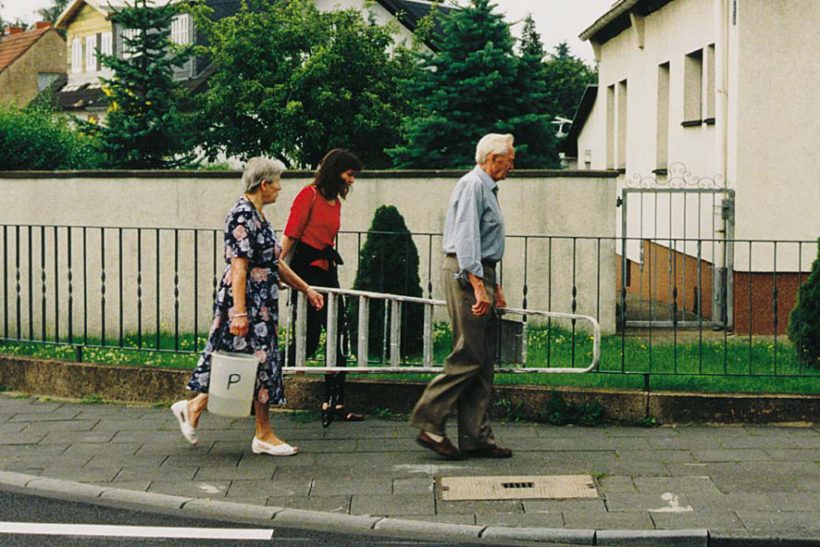
ZWISCHEN VIER UND SECHS © Corinna Schnitt
Our filmmaker portrait for this issue is devoted to Corinna Schnitt.
Born in 1964 in Duisburg and now living in Cologne, Schnitt has been intriguing audiences at international festivals with her short films for over ten years and is now increasingly presenting her work on the art scene as well. Her carefully composed and dramatized films, which sometimes make it seem as if there were no such thing as a boundary between documentary and fiction, are finely observed, ironic commentaries on everyday middle-class life.
Corinna Schnitt’s artistic career has been steady and consistent. She studied art and visual communication in Offenbach and Düsseldorf, where she took master classes at the Art Academy. Already during her studies, which she completed in 1996, she reaped acclaim with her 16 mm film “Schönen guten Tag, Frau Schnitt” (“Hallo Ms. Schnitt”), and has demonstrated an amazing continuity in her artistic work ever since.
Her films structure and survey surroundings that are all too familiar to us. They bring middle-class existence to the screen in all of its banality, unvarnished and yet somehow fresh.
The surprising peculiarities of bourgeois life are what spark her interest, and she presents her own ironic take on these throughout her still modestly sized oeuvre. Her works are never designed to mercilessly expose their subjects, but rather evince a certain affection for the milieu she is describing. Nevertheless, Schnitt’s artistic approach goes far beyond the “milieu films” of the “Cologne Group”.
A wonderful example of this is her fictional family portrait “Zwischen vier und sechs” (“Between Four and Six”). The favourite pastime of the small family depicted in the film is to spend the weekend going through their neighbourhood and cleaning the street signs. Thanks to the well-chosen cast, the off-screen commentary of the adult daughter and the familiarity of the scenery, this glimpse of family life has an almost documentary character. The absurd plot is presented as something completely natural, so that Sunday sign-cleaning seems at most an unusual quirk, but never ridiculous.
Rituals of middle-class existence are also the theme of “Raus aus seinen Kleidern” (“Out of Your Clothes”). A young woman stands on the balcony of her flat and shakes out a sweater for several minutes. The camera zooms out from the monotonous scene until the woman is only a tiny speck. Here as well, Schnitt uses the audio level for a commentary on the woman’s somewhat neurotic behaviour.
Like “Between Four and Six”, “Das schlafende Mädchen” (“The Sleeping Girl”) was also filmed in a neighbourhood of terraced homes. The central aesthetic element is an extended camera pan through the new settlement, where every house looks exactly the same. The grand-scale sweep across the apparently deserted landscape ends with a view through a window at the Vermeer painting for which the film is named. While Justyna Feicht’s camera focuses in on the picture, the answering machine goes on and an insurance salesman holds a monologue about life insurance and lost pens.
“Living a Beautiful Life” is a docu-fiction hybrid: here, the setting is an ultramodern villa in Los Angeles, the home of an equally stylish couple. They talk about their perfect life, in which everything is just as painstakingly composed as their house and the film itself.
Schnitt’s skill at montage, set-planning, selection of props and image composition give her an exceptional standing in the German film scene, and thus it is no surprise that, in addition to her festival acclaim, she has also captured the attention of the art world. The many grants and awards she has received for her work allow us to hope that she will be able to carry forth on her path as a strong-willed film author with a unique sensibility.
Filmography:
“Schönen, guten Tag” (Hallo Ms. Schnitt, 16 mm, 1995)
“Zwischen vier und sechs” (Between Four and Six, 16 mm, 1997/98)
“Raus aus seinen Kleidern” (Out of Your Clothes, 16 mm, 1998/99)
“Das nächste Mal” (The Next Time, SVHS, 1999)
“Das schlafende Mädchen” (The Sleeping Girl, 16 mm, 2001)
“Schloss / Solitude” (16 mm, 2002)
“Freizeit” (Free Time, 16 mm, loop, five-part series, film/television)
“Living a Beautiful Life” (mini DV, 2003)